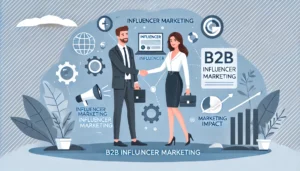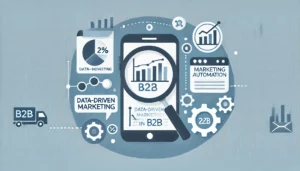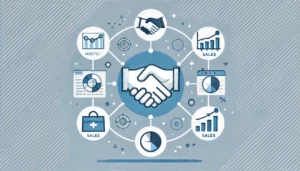Strategies for Effective LinkedIn Content

LinkedIn is a powerful platform for B2B marketing, offering a unique space to connect with professionals, industry leaders, and potential clients. To maximize the benefits of LinkedIn, it’s essential to create and share content that resonates with your audience. This blog will explore strategies for crafting effective LinkedIn content that drives engagement and fosters meaningful connections.
Understanding Your Audience
Before you start creating content, it’s crucial to understand who your target audience is. Identifying your audience’s demographics, interests, and pain points will help you tailor your content to meet their needs and preferences. Conducting audience research and leveraging LinkedIn’s analytics can provide valuable insights into your audience’s behavior and preferences.
Creating Engaging Content
Effective LinkedIn content is engaging, relevant, and valuable to your audience. Different types of content perform well on LinkedIn, including text posts, articles, images, and videos. To create compelling posts and articles, focus on providing actionable insights, sharing industry news, and showcasing your expertise. Consistency in style and tone also helps in establishing a recognizable brand voice.
Utilizing Visual Content
Visual content, such as images and videos, tends to attract more engagement on LinkedIn. High-quality visuals can make your posts more appealing and help convey your message more effectively. When creating visual content, ensure that it is relevant, professional, and aligns with your brand’s identity. Infographics, charts, and short videos are particularly effective in capturing attention and driving engagement.
Crafting Powerful Headlines
Headlines play a crucial role in capturing your audience’s attention. An effective headline should be clear, concise, and compelling. It should also include relevant keywords to improve visibility in searches. Use power words, numbers, and questions to make your headlines more engaging. For example, “5 Proven Strategies for Effective LinkedIn Content” is likely to attract more clicks than a generic headline.
Leveraging LinkedIn Features
LinkedIn offers various content features that can enhance your marketing efforts. Utilizing these features effectively can help you reach a broader audience and increase engagement.
LinkedIn Articles and Posts
LinkedIn provides two primary content formats: Articles and Posts. Articles are long-form content pieces that can be used to share in-depth insights and expertise. They are ideal for thought leadership and detailed discussions. Posts, on the other hand, are shorter updates that can include text, images, videos, or links. They are perfect for quick updates, sharing news, or engaging with your audience.
LinkedIn Stories and LinkedIn Live
LinkedIn Stories and LinkedIn Live are powerful tools for engaging your audience in real-time. Stories allow you to share short, ephemeral updates that are visible for 24 hours. They are great for sharing behind-the-scenes content, quick tips, and daily highlights. LinkedIn Live enables you to broadcast live video content, which can be used for webinars, interviews, and live Q&A sessions. Both features help in creating a more dynamic and interactive presence on LinkedIn.
Consistency and Timing
Consistency and timing are key factors in maintaining an active and engaging LinkedIn presence. Posting regularly ensures that your audience stays engaged and keeps your brand top of mind.
Building a Content Calendar
Creating a content calendar can help you plan and organize your LinkedIn posts. A content calendar allows you to schedule your posts in advance, ensuring that you maintain a consistent posting schedule. It also helps in planning content around important dates, events, and campaigns. Tools like Hootsuite, Buffer, and LinkedIn’s native scheduling feature can assist in managing your content calendar.
Frequency of Posting
Determining the right frequency for posting on LinkedIn is essential for maintaining engagement without overwhelming your audience. While there is no one-size-fits-all answer, a good starting point is to post at least once a week. As you gather data on your audience’s preferences, you can adjust the frequency to find the optimal posting schedule. Balancing quality and quantity is crucial; it’s better to post high-quality content less frequently than to post low-quality content daily.
Engaging with Your Audience
Engagement goes beyond just posting content; it involves actively interacting with your audience. Responding to comments, messages, and mentions helps build relationships and fosters a sense of community around your brand.
Responding to Comments and Messages
Taking the time to respond to comments and messages shows your audience that you value their input and are interested in engaging with them. Personalized responses can make a significant impact and encourage further interaction. Additionally, responding promptly to messages and inquiries can enhance your brand’s reputation for customer service and professionalism.
Encouraging Interaction and Community Building
Encouraging interaction through questions, polls, and discussions can increase engagement and create a sense of community. Asking thought-provoking questions or seeking opinions on industry topics can spark conversations and generate valuable insights. LinkedIn Polls are a great way to engage your audience and gather feedback on specific issues.
Measuring Success and Optimizing
Tracking the performance of your LinkedIn content is essential for understanding what works and what doesn’t. Using analytics to measure success and optimize your strategy ensures that you continue to improve and achieve better results over time.
LinkedIn Analytics Tools
LinkedIn offers robust analytics tools that provide insights into your content’s performance. These tools track metrics such as post impressions, engagement rates, follower demographics, and more. By regularly reviewing these metrics, you can identify trends and patterns that can inform your content strategy.
Adjusting Your Strategy Based on Data
Data-driven decision-making is key to optimizing your LinkedIn content strategy. Use the insights gained from LinkedIn analytics to adjust your content, posting frequency, and engagement tactics. Experiment with different types of content, posting times, and engagement strategies to find what works best for your audience. Continuous optimization based on data will help you achieve better results and drive more meaningful engagement on LinkedIn.
Case Studies of Successful B2B Campaigns
Examining successful B2B campaigns on LinkedIn can provide valuable insights and inspiration for your own marketing efforts. Here are a few examples of companies that have effectively utilized LinkedIn for B2B marketing:
Example 1: Microsoft
Microsoft has leveraged LinkedIn to share thought leadership content, engage with their audience, and promote their products and services. By regularly posting articles, updates, and videos, Microsoft has established itself as a leader in the tech industry and built strong relationships with other businesses.
Example 2: HubSpot
HubSpot uses LinkedIn to share educational content, such as blog posts, webinars, and eBooks. This content not only provides value to their audience but also positions HubSpot as an authority in the marketing and sales space. Their targeted advertising campaigns have also been successful in generating high-quality leads.
Conclusion
LinkedIn is an essential platform for B2B marketing due to its professional network, lead generation capabilities, targeted advertising options, and engaging content formats. By leveraging LinkedIn’s features and utilizing data-driven strategies, businesses can effectively reach their target audience, build professional relationships, and drive growth. Incorporate LinkedIn into your B2B marketing strategy today to take advantage of its unique benefits and elevate your brand.
FAQs
1. What types of content work best on LinkedIn for B2B marketing?
Content that provides value, such as industry insights, how-to guides, and thought leadership articles, tends to perform well on LinkedIn. Visual content, such as infographics and videos, also garners high engagement.
2. How often should I post on LinkedIn?
It’s recommended to post at least once a week. However, the optimal frequency may vary depending on your audience’s preferences. Regularly monitor your LinkedIn analytics to determine the best posting schedule for your business.
3. What are LinkedIn Polls, and how can I use them?
LinkedIn Polls are a feature that allows you to ask your audience questions and gather their responses. Polls are great for engaging your audience and gaining insights into their opinions and preferences. They can be used to gather feedback on products, industry trends, or any other relevant topic.
4. How can I measure the success of my LinkedIn content?
Use LinkedIn’s analytics tools to track key metrics such as post impressions, engagement rates, and follower demographics. Regularly reviewing these metrics will help you understand what content resonates with your audience and allows you to optimize your strategy accordingly.
5. What are LinkedIn Stories and LinkedIn Live?
LinkedIn Stories are short, temporary posts that disappear after 24 hours. They are ideal for quick updates, behind-the-scenes content, and daily highlights. LinkedIn Live is a feature that allows you to broadcast live video content, perfect for webinars, interviews, and live Q&A sessions.





